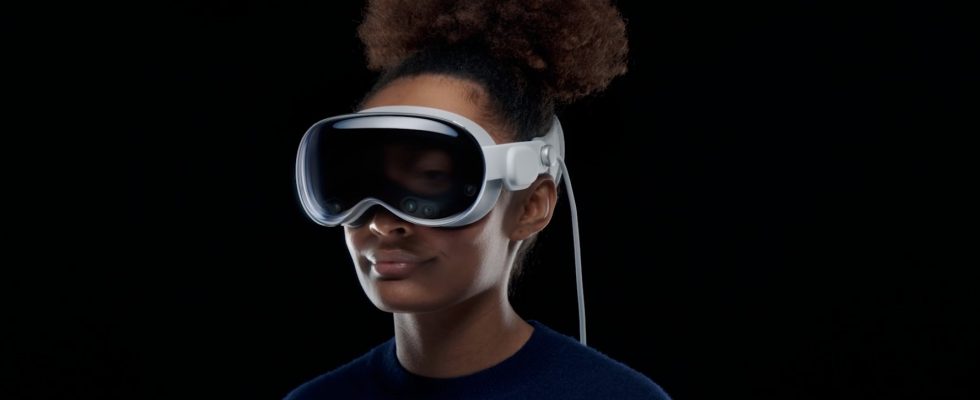The fight has really started this time. After years of patient development, Apple has entered the crowded virtual reality headset market. During its major annual WWDC conference on June 5, the firm unveiled the “Apple Vision Pro”, its brand new immersive headset which will be marketed in early 2024 at a price of 3499 dollars. A historic moment for the apple firm which – if we exclude the remunerative Airpods in the accessories sector – had not launched a new category of products since the Apple Watch in 2014. Above all, with its headphones, the apple firm provides a stunning solution to the biggest puzzle in tech.
For years, a myriad of groups (Meta, Microsoft, Sony, etc.) have been trying to get the virtual reality market off the ground. This turns out to be much harder than expected for several reasons. First, despite the undeniable progress in graphic rendering, we are still far from being able to take the Internet user into the sophisticated virtual world that Mark Zuckerberg dangled us in 2021. Developing headsets powerful enough to immerse us in a virtual world , while remaining autonomous, light and comfortable, is also incredibly complex. Last problem that Tim Cook has identified very well: virtual reality headsets isolate the user from the outside world, which does not make you want to use them on a daily basis.
Apple Vision Pro: the computer of the future
As usual, Apple chose not to rush. His approach to the subject was ingenious. Not more than its competitors, the firm does not manage for the moment to propose to the Net surfers to penetrate in an incredible virtual universe. The uses she explained for her headset are all in all fairly standard (Internet browsing, office automation, video, etc.). What makes the experience very innovative, however, is the radically different way in which you can now use these services. The firm has indeed made the clever choice of “mixed” reality: its device very realistically reproduces our real environment and positions virtual elements there.
The Internet user can thus put on his helmet and launch a video, while moving around his living room: he does not risk colliding with a piece of furniture or a person. The way in which Apple integrates, in space, the windows with the faces of our interlocutors almost gives the impression that the people are in the same room. Tim Cook’s teams also had the good idea of artificially reproducing the wearer’s face on the outside of the helmet. It’s done so realistically that the headset looks transparent (which it isn’t). A technical feat that greatly reduces the insulating nature of this type of device.
The fact that virtual contents (Internet browsing window, video, etc.) are intelligently integrated into real space and the way Apple proposes to interact with them makes the idea of using headphones instead of headphones attractive. a computer to check emails, surf or work on files. It is very easy to switch from one virtual element to another: just look at it. The headset then highlights the content you are looking at and – if it is the one you want to select – a slight wave of the hand confirms it. Commands can also be made by voice.
In the demos presented yesterday, the image quality seems very good (“a 4K screen in front of each eye”) which makes the idea of watching a movie with your headphones finally appealing. To design this little jewel of technology, Apple filed no less than 5000 patents and integrated 12 cameras, 5 sensors and 6 microphones. The firm has also worked on the audio part and developed a privacy protection system: the user is recognized thanks to an iris scan and outside companies do not have access to certain very revealing data – which attracts the gaze of the user on an Internet page for example.
Black spots and uncertainties remain, however. In its presentation videos, Apple boasts, for example, the use of headphones to immortalize the good times of everyday life. But even if the helmet insulates less than competing products, it’s hard to imagine spending an afternoon with the family with the device on your eyes to take souvenir photos. The autonomy of the “Apple Vision Pro” is only 2 hours and its price of 3500 dollars is obviously very high. Finally, we will have to wait for the first tests of the device to confirm a crucial point: is the comfort good enough that we want to put it on frequently for work or entertainment? This is the condition sine qua non so that the helmet becomes the computer of tomorrow.
Video games, e-commerce… the virtual world revolution
However, the product seems very convincing and should become even more so in the future, as new content and services are developed for these devices. Already, virtual and/or augmented reality headsets are shaking up the world of video games and professions that use a lot of simulations (industry, health). Sports coaching and well-being applications (immersion in a meditative environment, etc.) should also find interesting prospects in virtual reality. WWDC guest of honor Bob Iger, CEO of Disney also showed how the headset could immerse viewers in matches “augmented” with statistics or spatial representations of players.
Immersiveness will also revolutionize e-commerce by allowing consumers to view a product in real dimensions without going to the store, or even perhaps tomorrow to have an avatar try it on our scale. “Apple Vision Pro is the first generation of a product that is a long-term bet: the idea that connected objects and glasses will be the next main platform for viewing digital content by 2030, summarizes Neil Mawston, director partner at analyst firm TechInsight. Today we’re looking at our phones, tomorrow we’ll be looking through our glasses.”
